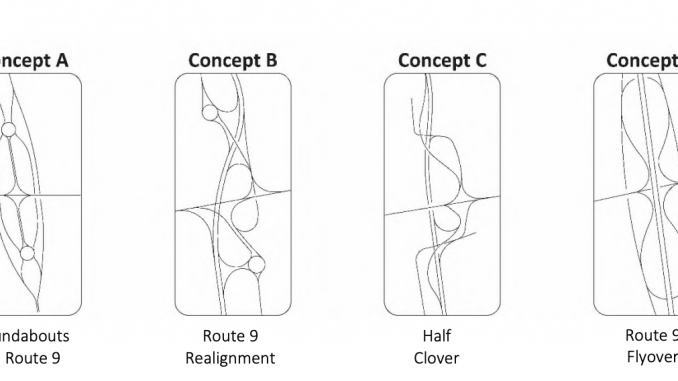
After a nearly three year long study managed by the Dutchess County Transportation Council (DCTC), the Executive Summary for the Poughkeepsie 9/44/55 Rethinking the Arterials and Interchange was made public at the end of last month — meaning construction of the redesign should be on the way soon.
The study includes analysis from traffic conditions, interviews with stakeholders and residents, crash and accident statistics and conceptual design plans. It was created in order to “dramatically improve how people travel to, within, and through Poughkeepsie,” according to the Executive Summary. “The Route 9/44/55 Interchange and Route 44/55 Arterials regularly serve high volumes of traffic and experience high rates of crashes. The DCTC is undertaking Poughkeepsie 9/44/55 to explore how these two facilities can be redesigned to improve safety and travel time reliability, while also making them better integrated with the fabric of Poughkeepsie.”
“The 9/44/55 Interchange has an unconventional configuration and includes features such as left side ramps and short weaving distances that contribute to driver confusion and conflicts,” says the DCTC. “The Arterials and Interchange both experience crash rates substantially above the statewide average for similar facilities. This includes the section of the westbound Arterial on Columbus Drive near Main Street, where weaving is a concern.”
According to the public crash data, which includes crash reports from Jan. 1, 2016 to Dec. 31, 2018, the 9/44/55 interchange saw 1,373 crashes within those two years, including pedestrian, bicycle and vehicle accidents.
The existing condition assessment portion of the study concluded that a large number of residential households in the area do not own a vehicle and must rely on either public transportation or other secondary modes of travel to get to their destinations. The problem is that the 9/44/55 interchange separates the residential areas from the commercial areas, meaning pedestrians are required to cross the vehicle-oriented, three-lane Arterial, where the average speed is 10 miles-per-hour above the posted limit, posing serious health hazards and safety risks.
After gathering the necessary data and analyzing all of the current residential concerns, the DCTC came up with 13 preliminary design concepts for the Interchange to improve safety and operations. Of the concepts, four emerged as the most viable, but are still subject to further public review and detailed analysis.
Concept A, nicknamed “Roundabouts on Route 9,” is the option that seemingly achieves most of the project objectives, appears to be the simplest and most feasible to construct and can be built at a lower cost than the other three concepts.
As for the Arterial, only two concept designs were created called the 3 to 2 concept and the two-way concept.
“The 3 to 2 Concept maintains one-way traffic on the Arterials and reduces the number of travel lanes on each Arterial from three to two, allowing the remaining pavement to be reallocated for bicycle lanes, parking, bus stops, loading zones, or green space. The Two-Way Concept converts both Arterials to two-way streets, providing a single lane in each direction with a center two-way left turn lane,” says the Executive Summary.
Currently, the 3 to 2 concept is preferred by the Executive Board, however “both concepts are expected to improve safety for all road users compared to existing conditions but will likely operate at or near capacity for drivers during the typical morning and late afternoon commute times (peak hours).”
The study was noted as one of the most challenging and ambitious undertakings by the DCTC in its 40-year history, and the conclusion of the study is only the beginning of an ongoing project to make these recommendations a reality.
